Okra is a warm-season vegetable that is easy to grow in most parts of the United States. If you’re growing Okra in the United States, read this article for soil, propagation, planting, care, and farming tips. Okra likes full sun and well-drained soil.
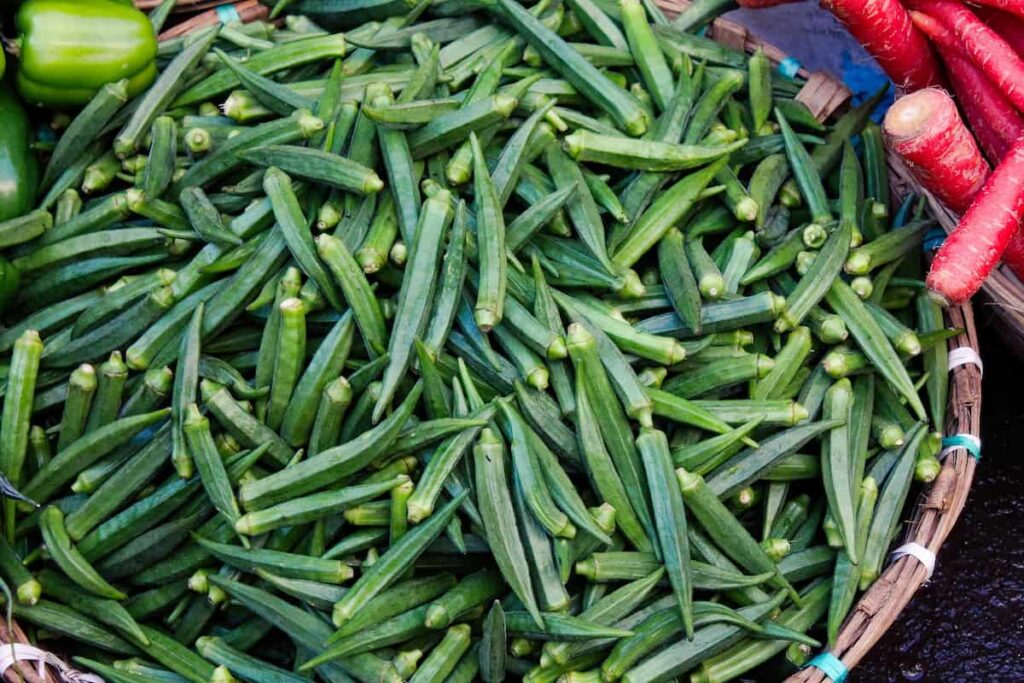
How to grow Okra in USA
Soil for Growing Okra in the USA
The first step to growing Okra in the USA is preparing the soil. The best soil for growing Okra is sandy loam with a neutral pH. If your soil is too acidic or alkaline, it can affect the growth of your plants. You can purchase a testing kit at your local nursery or gardening store to test your soil’s pH. When preparing the soil for planting, add plenty of organic matter to help improve drainage and aeration. Okra plants prefer soils that are high in organic matter and well-drained. After you have prepared the soil, you will need to propagate your Okra plants.
Okra growing areas in the USA
- In the USA, much of the supply is grown in Florida, especially around Dade in southern Florida. Okra plant is grown throughout the state to some degree, so it is available ten months of the year.
- In the United States, Okra is grown in the southern states, as well as California and Hawaii.
- In the United States, Okra can be grown in all states that have a long growing season with warm weather, including Alabama, Louisiana, Mississippi, North Carolina, Arkansas, Florida, Georgia, South Carolina, Tennessee, and Texas.
Growing Okra in containers in the USA
- Growing Okra in containers is a great way to enjoy this nutritious vegetable, even if you don’t have a lot of space. Okra plants can be grown in containers at least 12 inches deep and have drainage holes.
- When choosing a container for your Okra plant, select one large enough to accommodate the plant’s roots and allow for proper drainage. If you use a plastic container, drill several holes in the bottom for drainage.
- Select a container for growing Okra at least 12 inches deep and 12 inches wide in pots. Fill the pot with a well-drained potting mix, and water it thoroughly.
- Sow Okra seeds ½ inch deep in the potting mix. Fertilize every two weeks with a half-strength fertilizer solution.
- When the Okra seedlings are about 4 to 6 inches tall, thin them so that only the strongest plant remains in each pot.
- Fill your container with a high-quality potting mix and add some organic matter, like compost or manure, to help the plants grow. Okra plants need full sun to produce the best yields, so choose a location in your yard or your patio that receives 6 hours of sunlight per day.
- To propagate Okra plants, you can start with seeds or transplants.
- When planting Okra in containers, space plants about 12 inches apart, so they have room to grow.
- Water your plants regularly, and fertilize them every two weeks. When the Okra pods are 3 to 4 inches long, harvest them by cutting them from the plant with a sharp knife. Water plants deeply and regularly, especially during hot, dry weather. Add a layer of mulch around the plant base to help retain moisture and control weeds.
- Harvest Okra pods when they are 3-4 inches long by cutting them from the plant.
In case you missed it: Okra Pests, Diseases, Symptoms, And Control Measures
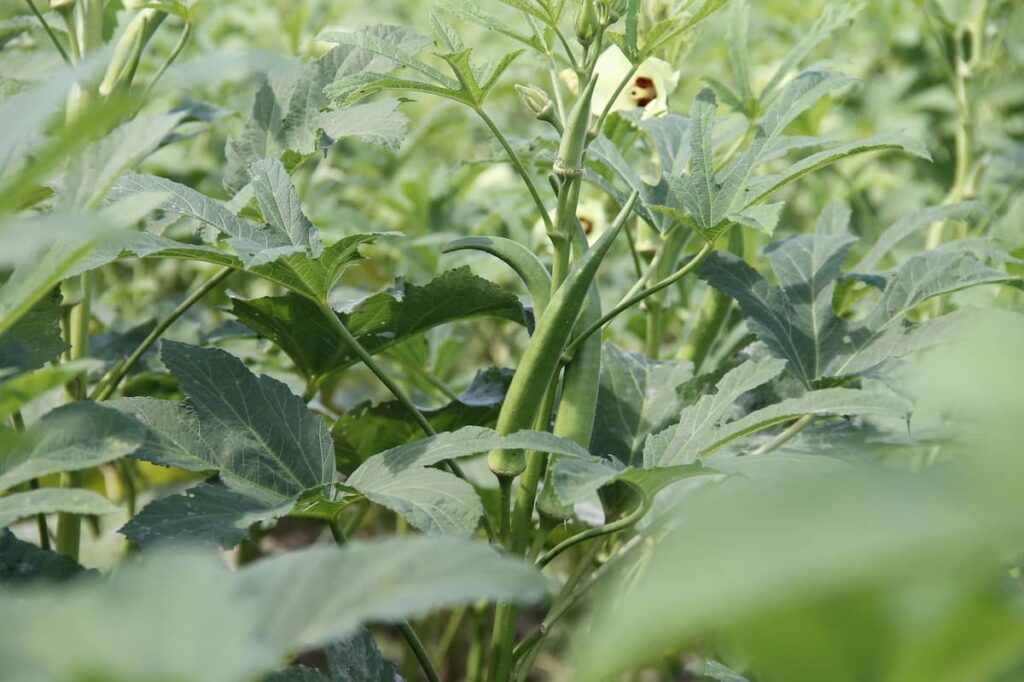
Okra farming tips in the USA
Okra farming is a popular and rewarding activity in the USA. You can easily grow Okra in your backyard or farm with suitable soil, propagation, and planting methods.
- Soil: Okra grows best in well-drained, sandy loam soils with a pH of 6.5 to 7.5.
- Propagation: You can propagate Okra by seeds or cuttings. Seeds should be sown 1/2 to 1 inch deep in well-prepared soil. Cuttings should be taken from young, healthy Okra plants and rooted in vermiculite or moist sand.
- Planting: Seedlings or transplants should be planted 12 to 24 inches apart in rows about 3 to 4 feet apart. Plants should be spaced evenly to have room to grow and produce plenty of Okra pods.
- Care: Okra plants need full sun and consistent moisture throughout the growing season. Water deeply and regularly, especially during dry periods. Fertilize the plant monthly with a balanced fertilizer such as 10-10-10. Harvest Okra pods when they are 3 to 4 inches long; cut them from the plant using a sharp knife or shears.
Okra varieties in the USA
Clemson Spineless
This is the most popular variety of Okra in the US. It is a high-yielding plant that produces long, slender, spineless pods.
Alabama Black
This variety of Okra is native to the southeastern United States. It is a tall plant that produces dark green, oval-shaped pods.
Burgundy
This variety of Okra is characterized by its reddish-purple color. It is a medium-sized plant that produces oval-shaped pods.
Cajun Delight
This variety of Okra was developed in Louisiana. It is a compact plant that produces light green, cylindrical-shaped pods.
Okra varieties in California
Most California commercial Okra cultivars are green, ribbed, spineless types. Clemson Spineless, the standard open-pollinated variety, has been grown for over 40 years. It is still used because of its low seed cost and wide adaptation. Its dark green pods are slightly grooved, and the plants are about 4 feet (1.2 m) tall. Clemson Spineless 80 is an open-pollinated selection from Clemson Spineless with shorter plants and greater uniformity.
Annie Oakley F1 is a prolific hybrid that produces bright green pods and nearly doubles the yield of standard varieties. Growers are reluctant to plant it because the seed is much more expensive than open-pollinated varieties. Other varieties that have been grown or are under trial include Green Best F1, Penta-Green OP, Annie Oakley II, Emerald, Picacho, Velvet, and Lee.
In case you missed it: Growing Okra in Australia: At Home, Planting Season, and Guide
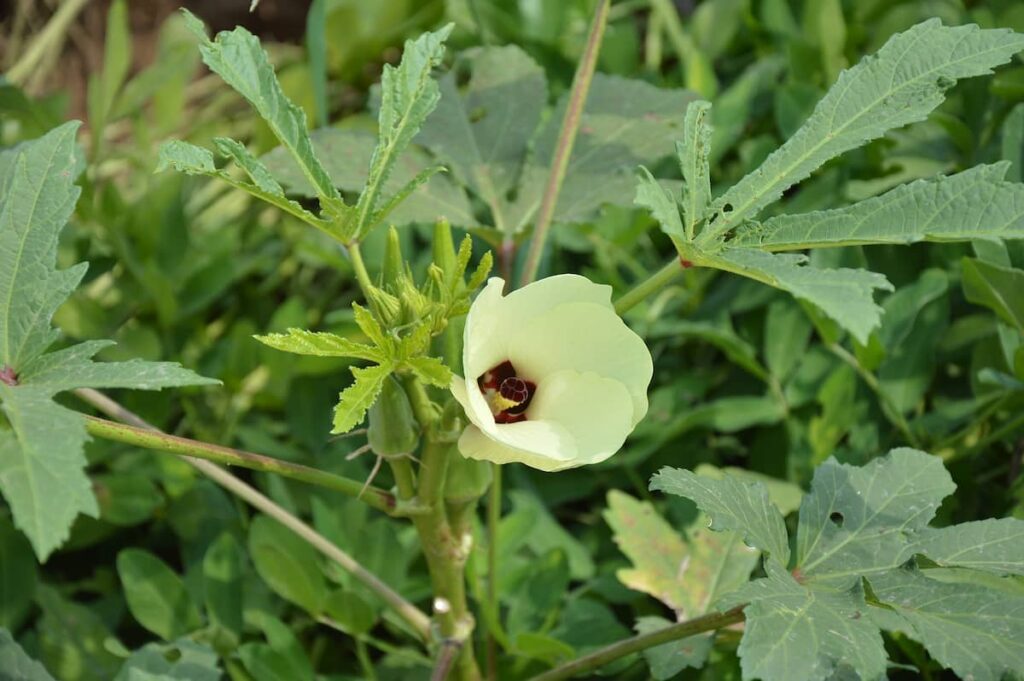
Okra growing indoors
Okra can be grown indoors in containers. Use a well-draining potting mix and place the container in a sunny location—water Okra plants when the top inch of soil is dry. Apply a balanced fertilizer every 2-3 weeks. Allow the plant to grow 24-36 inches before harvesting the pods.
Okra growing season in the USA
Okra is a warm-season vegetable that is usually grown as an annual. In the United States, it is typically planted in late spring or early summer. You can plant Okra as early as February or March. However, if you live in a region with a shorter growing season, it’s best to wait until May or June to plant Okra. Once you’ve decided when to plant Okra, choosing the right type of seed is essential. There are two main types of Okra seeds: hilled and bush. Hilly seeds are best suited for planting in rows, while bush seeds can be planted in hills or mounds.
Fertilizer tips for Okra production
Okra is a heat-loving plant that thrives in warm weather and soil. Here are a few tips for fertilizing Okra:
- Use a well-balanced fertilizer that is high in nitrogen. Okra is a heavy feeder that needs plenty of nitrogen to produce good yields.
- Apply fertilizer before planting, at planting time, and then again about six weeks later. This will give the plants a good start and keep them growing strong throughout the season.
- Side dress with compost or aged manure about halfway through the growing season. This will add some essential nutrients to the soil and help the plants continue producing well.
- Avoid using too much fertilizer, which can cause the plants to produce fewer fruits. Just use enough to boost them and then let them do their thing.
How to propagate Okra?
Okra can be propagated from seeds or cuttings. Sow the Okra seeds in pots or trays filled with moist potting mix to propagate from seed. Cover the pots or trays with plastic wrap or a lid to maintain high humidity and keep the soil warm. Place the pots or trays in a warm location out of direct sunlight until the seeds germinate, which usually takes 5-10 days. Once the seeds have germinated, remove the plastic wrap or lid and place the pots or trays in a sunny location.
To propagate Okra from cuttings, take 4–6-inch stem cuttings from an existing Okra plant. Remove all but the top 2 leaves from each cutting and dip the cut end of cutting into rooting hormone powder. Place the cuttings in pots or trays filled with moist potting mix and cover them with plastic wrap or a lid. Cuttings can be rooted in water or moistened potting mix. Place them under indirect light and keep the temperature around 21°C until they have rooted and are ready to transplant.
In case you missed it: Red Okra vs Green Okra: Which Makes You Rich?
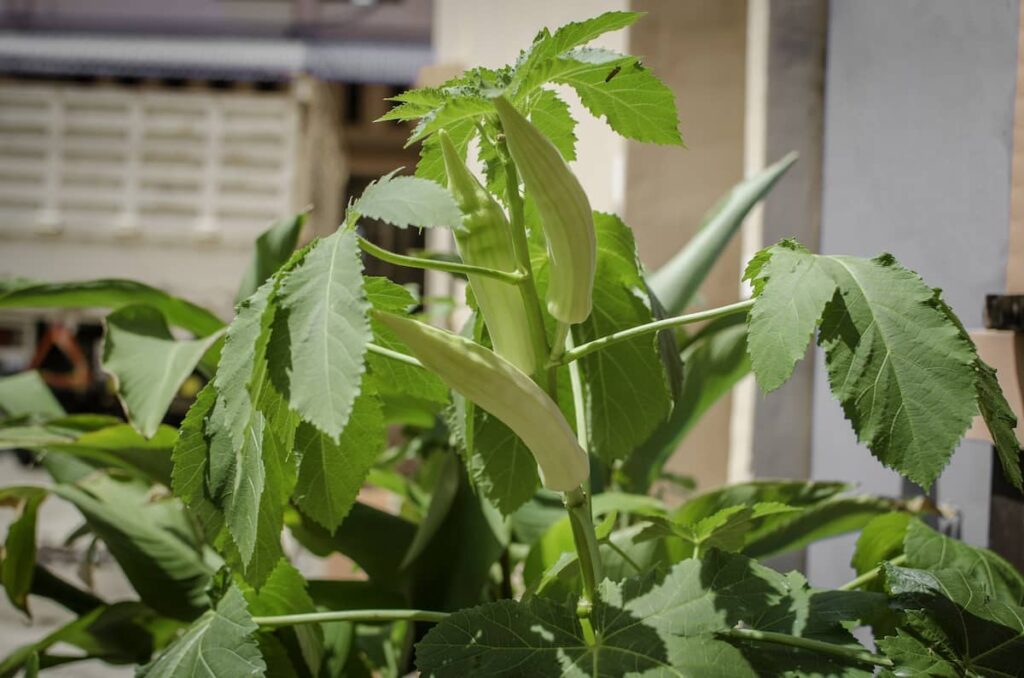
How to make Okra produce more?
Okra is a tropical plant typically grown in hot, humid climates. It is possible to grow Okra in the United States, but it may require extra care.
- Start with high-quality seeds or transplants. Look for varieties that are known to be productive in your area.
- Plant in well-drained, fertile soil. Add compost or other organic matter to help improve drainage and fertility.
- Water regularly, especially during dry spells. Okra plants need consistent moisture to produce lots of fruit. Water Okra regularly during the growing season, especially during dry periods. Apply water at the base of plants to avoid wetting leaves, promoting fungal diseases. Fertilize Okra every 4-6 weeks with a general-purpose fertilizer or compost tea.
Irrigation management for Okra growing in the USA
The crop may be planted in moist soil (mulch planting) or furrow-irrigated for the initial irrigation. If the soil has adequate moisture at planting, the young seedlings will grow to 3 to 5 inches (7.5 to 12.5 cm) before another irrigation is needed. Excessive irrigation in chilly weather tends to cool the soil and retard plant growth.
As the plants mature, the crop should not be stressed for moisture if maximum yields are obtained. At harvest, irrigate alternate furrows (depressions between rows) to provide a dry place to walk during harvest. Subsequent irrigation should be applied to the dry furrow.
Okra yield in the USA
Okra is a warm-season crop typically planted in late spring or early summer. In the United States, most Okra production occurs in Mississippi, Alabama, and Louisiana. The average yield of Okra in the United States is approximately 10-15 bushels per acre. However, yields can vary significantly depending on the variety of Okra planted, growing conditions, and other factors. To maximize yield potential, it is essential to plant Okra in well-drained soil with organic matter.
Okra growing problems in the USA
- Okra is a warm-season crop traditionally grown in the southern United States. However, Okra can also be successfully grown in other parts of the country. For example, Okra can be grown as a summer annual in the northern United States.
- Okra prefers a long, hot growing season and does not tolerate frost. In the northern United States, Okra can be planted as early as 2 to 3 weeks before the last expected frost date. Okra seedlings should be transplanted after frost has passed.
- When growing Okra in the United States, choosing a planting location that receives full sun and has well-drained soil is essential. Okra also requires consistent moisture during the growing season. Irrigation may be necessary to supplement rainfall if drought conditions occur.
- Okra plants will continue to produce fruit throughout the summer until frost kills the plant. Okra will be harvested from late July through early October in most areas of the country.
In case you missed it: Top 15 Ways to Boost Okra Crop Yield: How to Increase production, Quality, Methods, and Tips
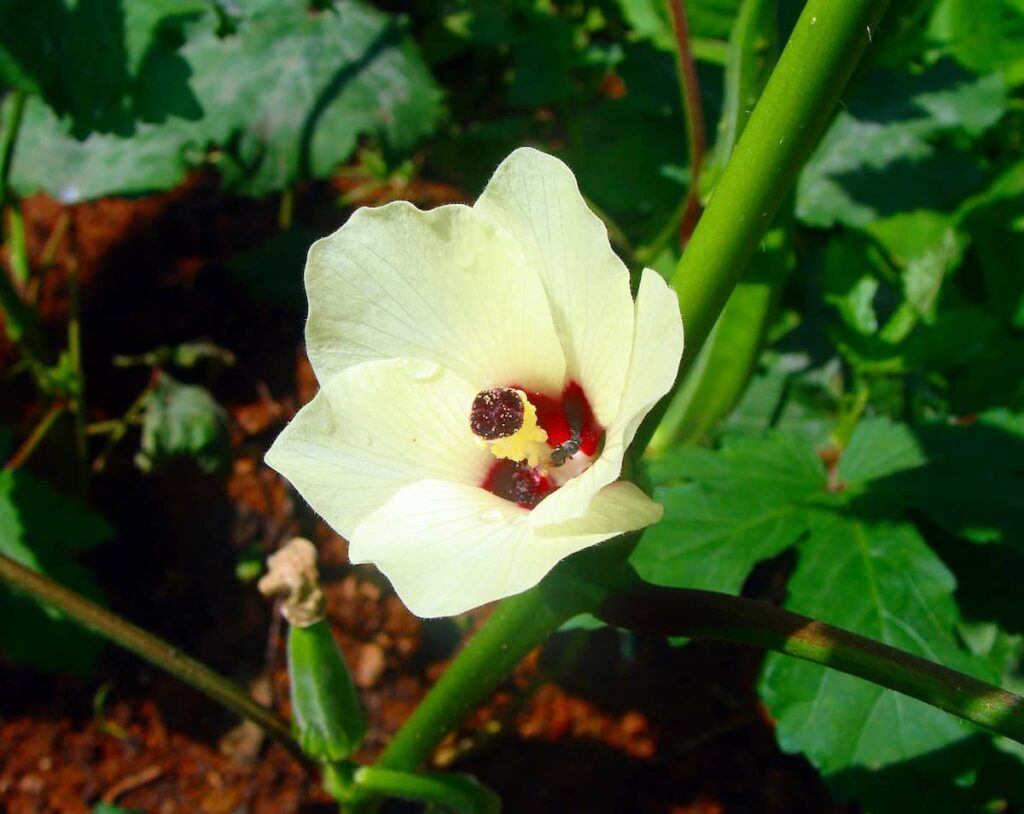
Pests, diseases, and their management for growing Okra
- Okra plants are relatively tolerant of pests and diseases but can be susceptible to root-knot nematodes and Verticillium wilt. To minimize problems with these pests, it is important to rotate crops annually and choose resistant varieties when possible.
- Pests and diseases are major problems when growing Okra. Okra is susceptible to pests such as aphids, caterpillars, and whiteflies. Diseases that can affect Okra plants include blossom-end rot and Alternaria leaf spot.
- Fortunately, there are many ways to control pests and diseases on Okra plants. One method is to use insecticidal soap or neem oil to kill pests. You can also remove infected leaves from the plant to prevent the spread of disease. If you see signs of pests or disease on your Okra plants, take action immediately to prevent severe damage.
Harvesting tips for Okra
Harvest Okra pods when they are about 2 to 4 inches long and still tender. The best time to pick up Okra is in the morning.
Okra marketing in the USA
Okra marketing in the USA can be challenging because of the lack of awareness about vegetables. Most people are familiar with Okra as a southern food, but it is not widely known that vegetables are relatively easy to grow in many different climates. Leading Okra-producing states are Texas, Georgia, California, and Florida. Supplies peak in June, July, and August. California ships Okra from June through October. Mexico exports Okra year-round, but exports to the United States are highest from June to September.
Frequently asked questions about growing Okra
Does Okra grow in America?
Okra is grown well in the South; it is not native to the USA. However, it is indigenous to many other parts of the World, including Western Africa and South East Asia.
Does Okra grow back every year?
When planting Okra in more temperate climate conditions, this perennial plant becomes an annual and must be replanted yearly. To plant Okra, it is best to soak the seeds overnight to improve germination.
In case you missed it: How to Grow Okra from Seed to Harvest: In Pots, On the Ground, A Full Detailed Guide for Beginners
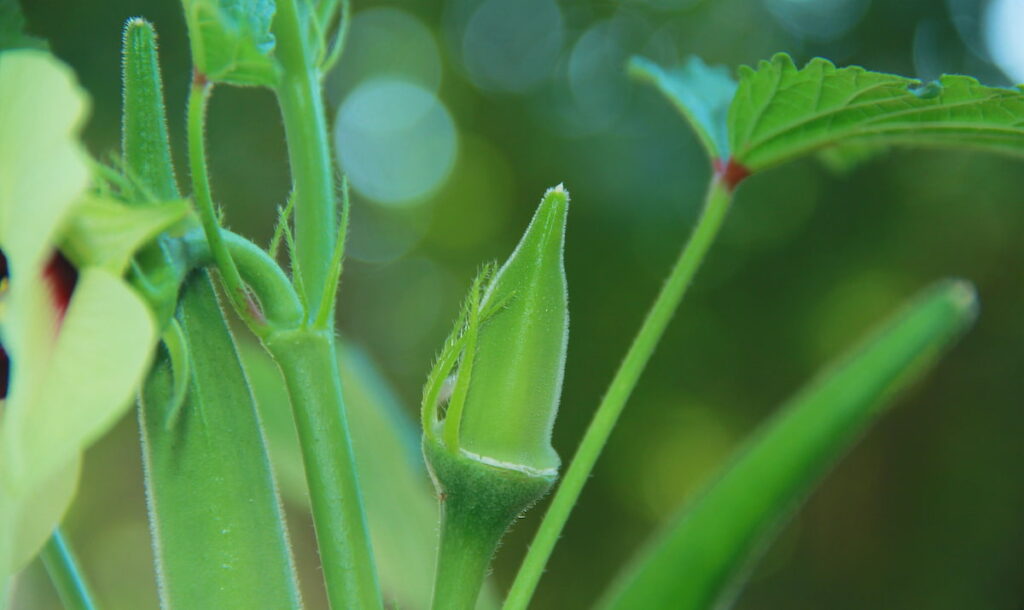
How many Okra will one plant produce?
If your Okra plants have ideal growing conditions, they can produce more than 20 – 30 pods per plant. In a warmer hardiness zone like zone 9b, and have a longer growing season, into the longer.
Does Okra need a lot of water?
Okra plant loves the heat and can grow well in a dry spell, but do your best to give Okra plants about 1 inch of water weekly.
Can you overwater Okra?
Okra needs a lot of water so having a water source close to your garden is a plus. That way, you can give them a good soaking once a week. Using watering can allow the droplets to be light on the plant. However, do not overwater Okra, as the roots may rot.
Conclusion
The plant is easy to grow and can be cultivated in various soils. It is a heat-loving plant that requires little care and can be grown in home gardens and farms. You can successfully grow this delicious and nutritious plant with a little care. There are many southern states in the United States that are suitable for growing Okra.
- Types of Pesticides Used in Agriculture: A Beginner’s Guide
- Economical Aquaculture: A Guide to Low-Budget Fish Farming
- 15 Common Planting Errors That Can Doom Your Fruit Trees
- How to Make Houseplants Bushy: Effective Tips and Ideas
- Innovative Strategies for Boosting Coconut Pollination and Yield
- Pollination Strategies for Maximum Pumpkin Yield
- The Complete Guide to Chicken Fattening: Strategies for Maximum Growth
- Natural Solutions for Tulip Problems: 100% Effective Remedies for Leaf and Bulb-Related Issues
- Revolutionizing Citrus Preservation: Towards a Healthier, Greener Future
- Natural Solutions for Peony Leaf and Flower Problems: 100% Effective Remedies
- Maximizing Profits with Avocado Contract Farming in India: A Comprehensive Guide
- Natural Solutions for Hydrangea Problems: 100% Effective Remedies for Leaf and Flowers
- The Ultimate Guide to Choosing the Perfect Foliage Friend: Bringing Life Indoors
- From Sunlight to Sustainability: 15 Ways to Use Solar Technology in Agriculture
- The Ultimate Guide to Dong Tao Chicken: Exploring from History to Raising
- The Eco-Friendly Makeover: How to Convert Your Unused Swimming Pool into a Fish Pond
- Mastering the Art of Delaware Chicken Farming: Essentials for Healthy Backyard Flocks
- 20 Best Homemade Fertilizers for Money Plant: DIY Recipes and Application Methods
- How to Craft a Comprehensive Free-Range Chicken Farming Business Plan
- Brighten Your Flock: Raising Easter Egger Chickens for Beauty and Bounty
- How to Optimize Your Poultry Egg Farm Business Plan with These Strategies
- Subsidy for Spirulina Cultivation: How Indian Government Schemes Encouraging Spirulina Farmers
- Ultimate Guide to Raising Dominique Chickens: Breeding, Feeding, Egg-Production, and Care
- Mastering the Art of Raising Jersey Giant Chickens: Care, Feeding, and More
- Ultimate Guide to Raising Legbar Chickens: Breeding, Farming Practices, Diet, Egg-Production
- How to Raise Welsummer Chickens: A Comprehensive Guide for Beginners
- How to Protect Indoor Plants in Winter: A Comprehensive Guide
- Ultimate Guide to Grow Bag Gardening: Tips, Tricks, and Planting Ideas for Urban Gardeners
- Guide to Lotus Cultivation: How to Propagate, Plant, Grow, Care, Cost, and Profit
- Agriculture Drone Subsidy Scheme: Government Kisan Subsidy, License, and How to Apply Online
- Ultimate Guide to Raising Araucana Chickens: Breed Profile, Farming Economics, Diet, and Care
- Bringing Hydroponics to Classroom: Importance, Benefits of Learning for School Students
- Ultimate Guide to Raising Polish Chickens: Breed Profile, Farming Economics, Diet, and Care
- Ultimate Guide to Raising Australorp Chickens: Profile, Farming Economics, Egg Production, Diet, and Care
- Silkie Chicken Farming: Raising Practices, Varieties, Egg Production, Diet, and Care
- Sussex Chicken Farming: Raising Practices, Varieties, Egg Production, Diet and Care